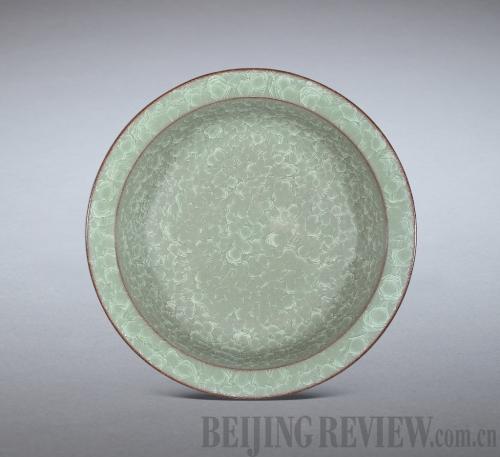|
 |
|
CRACKED-ICE: Porcelain ware made by Chen Tangen displays his sophisticated celadon firing technique (FILE) |
Over the past several decades, Chen Tangen collected soil materials in dozens of places in Longquan. He conducted firing experiments using different techniques, and after hundreds of tests and adjustments, he successfully produced the lavender grey and plum green glaze out of two ancient kilns. While in the process of seeking traditional celadon technology, Chen Tangen's achievement was uncovering the biggest mystery of celadon in the Song Dynasty: cracked glaze.
In the Song Dynasty, Longquan celadon was famous for two kilns, known as ge kiln and di kiln. Ge kiln was used primarily for imperial households while di kiln produced wares for average people. Celadon wares of the ge kiln are more precious thanks to their superb firing technology and artistic shape. Among the glaze types of ge celadon, the cracked-ice glaze stands out. Its exterior looks like a crack on the surface of a piece of ice. Nearly 1,000 years after the beginning of the Song Dynasty, many ceramic artisans attempted to recreate the cracked-ice glaze, but the technique was so complicated that none of them succeeded.
In 1996, Chen Tangen made up his mind to solve the mystery. "The first difficulty of firing cracked-ice celadon is to precisely control the proportion of base and glaze materials," Chen explained. "Even a tiny error will result in failure."
"The thickness of the glaze is also important. The cracks won't form if the glaze is too thin, and they will collapse if the glaze is too thick," Chen Tangen continued.
Furthermore, the artisan said, the carbon monoxide and temperature control during the firing stage directly affects the glaze. In short, the artisan must have strict and accurate control over every step of the process.
Chen Tangen did not give up on his goal, even after 300 failed experiments. "After every failure, I would examine the steps I took and summarize my experience. As a result, I moved a bit closer to success each time," Chen added.
One day in 2002, Chen Tangen reduced the kiln temperature to 100 degrees centigrade and slowly opened the kiln as usual. He heard a cracking noise from inside the kiln, and he saw on the surface of a ware appeared delicate cracked-ice texture, indicating the fantastic cracked-ice celadon was eventually reproduced successfully. A consummate technology that was lost for nearly 1,000 years was thereby recovered in Chen Tangen's hands.
Needed innovation
According to Chen Tangen, the quality of today's Longquan celadon has reached the top level of that of the Song Dynasty. However, he stressed that ceramic craftsmen must continue to seek innovation and breakthroughs.
Due to the limits of ancient technology, the celadon wares from the Song Dynasty were small. The high temperature during firing tended to make celadon ware deform and sag. For this reason, there was a saying in Longquan: "The bigger the ware, the more likely it will fail."
Over decades of research, Chen Tangen has adopted new formula to make celadon. He improves the processing technique of glaze to enhance its stability. Even the best celadon teapots in the Song Dynasty were merely 20 centimeters high, while Chen can make a 48-centimeter-high teapot, and a 1.4-meter-high vase.
With advancing technology, China, Japan and South Korea can produce celadon porcelain. Unlike Longquan, most of the other celadon wares are created with artificial chemical materials during processing. But in Longquan, artisans refuse to add artificial materials to fire celadon. "We stick to our traditional method," Chen Tangen said.
Though Chen Tangen's output is low (not more than 20 pieces of wares for each firing) the quality and value are high. He said Longquan celadon has the best reputation, even though it is not the most expensive of its kind.
"The unique glaze of Longquan celadon is due largely to local earth resources. The soil is our limited treasure, so we must cherish it. That's why we don't exploit the earth on a large scale for mass production," Chen Tangen said. "I hope the beautiful celadon as well as the natural environment of Longquan can be preserved for future generations."
Email us at: baishi@bjreview.com | 